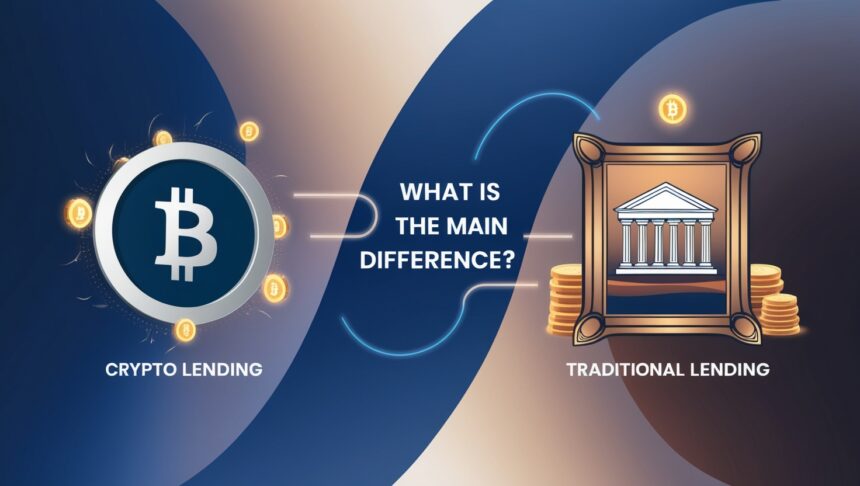In this article, I will explain the key distinction between crypto lending and conventional lending. Crypto lending occurs on blockchain platforms that provide quick, decentralized loans with crypto collateral.
Alternatively, traditional lending is governed by banks and financial institutions, which rely on credit evaluations and demand tangible collateral. Both systems have their own benefits, risks, and applications.
What is Crypto Lending?
Crypto lending offers a unique financial service where users can lend their cryptocurrencies in exchange for interest. This service is made possible on centralized platforms or DeFi protocols where lenders deposit their crypto into lending pools.

Borrowers offer collateral—usually in cryptocurrency—against the loans. Borrowers have to pay interest which differs based on market demand, asset type, and lending platform policies. For lenders, crypto lending is an easy way to earn a passive income while gaining interest from borrowers.
The borrowers have increased liquidity at their disposal without having to sell their assets. But it also holds some risks for lenders like market volatility, platform security, and collateral value dropping.
What is Traditional Lending?
Traditional lending is the process where banks, credit unions, or other financial entities provide loans to businesses or individuals in exchange for principal plus interest payments over time.
Loans can be either secured, meaning they require collateral such as real estate property or vehicles, or unsecured, meaning they are given solely based upon creditworthiness.

The lending process entails evaluating the borrower’s credit history, income, and compliance with various regulations as a risk factor. The borrower pays back the loan within a specified duration through pre-defined periodic payments.
Traditional lending helps an individual or business fulfill their personal requirements, purchase assets, or expand operations, which supports economic growth.
What is Main Difference Between Crypto Lending vs Traditional lending
| Feature | Crypto Lending | Traditional Lending |
|---|---|---|
| Collateral | Crypto assets (Bitcoin, Ethereum, etc.) | Physical assets (property, vehicles) or none for unsecured loans |
| Approval Process | Fast, minimal credit checks, over-collateralized | Slow, requires credit checks, income verification |
| Regulation | Partially regulated or decentralized | Highly regulated by financial authorities |
| Interest Rates | Higher and market-driven | Lower and influenced by central bank policies |
| Risk Factors | Volatility, smart contract risks, platform failures | Inflation, loan defaults, banking risks |
| Lender Returns | Higher potential returns (risk-dependent) | Stable but lower returns |
| Loan Accessibility | Global, accessible 24/7 | Limited by banking hours and geographical location |
| Repayment Terms | Flexible, often interest-only | Fixed installments over a set period |
| Security | Dependent on smart contracts & platform security | Backed by government regulations & insurance |
How Crypto Lending Works?
Through centralized (CeFi) and decentralized (DeFi) platforms, users are enabled to either lend or borrow cryptocurrency, and this is how crypto lending works. In return for interest, lenders place their crypto assets in a lending pool, and borrowers—typically in cryptocurrency—offer collateral to obtain a loan.
The loan-to-value (LTV) ratio indicates how much is available to be borrowed in proportion to the value of the collateral. If the collateral’s value drops below a certain level because market conditions are volatile, the platform can automatically liquidate the collateral to mitigate losses.
Compared to traditional loans, crypto lending is less time-consuming since there are minimal credit checks. Transactions occur immediately, making it easier to provide liquidity or earn passive income without the need to sell assets.
How Traditional Lending Works?
Conventional lending is done by banks, credit unions, and other financial institutions that grant loans considering the borrower’s credit history, income, and collateral. The process usually consists of an application, credit evaluation, income verification, and decision making, which in most cases depends on a risk analysis.
A loan may be secured (requiring a pledge of property such as buildings or automobiles) or unsecured (no collateral limitations but relies on credit reputation). The borrower pays back the money lent to him or her in equal monthly or quarterly installments, including interest for a certain period of time.
Factors such as policies from the central bank or economic situations would influence the rate of interest. traditional lending is done within a set of guidelines, which, in most cases, protect the users; however, the lending process takes an extensive amount of time after determining the requirements.
Key Components of Crypto Lending
Essential Aspects of Crypto Lending
Lenders – Persons or organizations who earn interest by depositing cryptocurrency.
Borrowers – Users who take out loans with a collateral in crypto.
Collateral – Crypto assets put forward by the borrowers as a security for loans to mitigate lenders risk.
Loan to Value (LTV) Ratio – percentage of loan given relative to the value of the collateral (say 50%-70%).
Interest Rates – Average interest is often greater than traditional lending which is set by the supply, demand and policies of the platform.
Smart Contracts – Protocols on blockchains that automate the execution of predefined agreements such as loans in peer-to-peer lending.
Liquidation Mechanism – The platform sells off collateral assets to repay the loan when the collateral value drops below the predetermined level.
CeFi vs. DeFi Platforms – CeFi (Centralized Finance) platforms like Nexo or BlockFi control the process of lending while DeFi (Decentralized Finance) platforms such as Aave or Compound use smart contracts.
Repayment Terms – Borrowers must repay the loan with interest, which they can do in various ways.
Risks & Security – Risk of market fluctuations, vulnerabilities of the smart contract, and the solvency of the platform pose security concerns.
Key Components of Traditional Lending
Lenders – Banks, credit unions, and other institutions that issue loans.
Borrowers – People or firms who take out loans in order to receive financial aid.
Collateral (For Secured Loans) – Loans backed by collateral such as real estate, motor vehicles, or savings.
Credit Score & History – Determines the approval and interest rate as financing risk is based on the borrower’s credit.
Loan Amount & Terms – Principal, interest rate, and repayment schedule as per lender’s loan policy.
Interest Rates – Set by the central banks and adjusted according to market conditions and the borrower’s risk.
Loan Types – Includes personal loans, mortgages, business loans, auto loans, and credit lines.
Regulatory Framework – Set by a governing body which safeguards the interests of consumers and fair use of practices.
Approval Process – Review of documentation, credit score, and income checks prior to approval.
Repayment Structure – Payments are made in regular fixed monthly installments with penalties for missed payments.
Crypto Lending Pros & Cons
Pros
High Returns – Lenders interest earns exceed what is earned from savings and lending.
Fast Approval – Minimal to no credit history checks; loan processing is completed quickly.
Global Accessibility – No geographical restrictions; accessible through blockchain platforms any time.
No Traditional Credit Requirements – Credit scores are not required for borrowers and loans are secured by collateral.
Flexible Repayment – Some platforms allow payment of interest only with customizable terms.
Decentralization (DeFi Lending) – Some platforms function as interless, reducing reliance on banks.
Cons
High Volatility – The dropping of the collateral value can occur significantly.
Security Risks – Risk for funding loss includes weak smart contracts and hacks into the structure of the platform.
Regulatory Uncertainty – Undefined boundaries of regulations could lead to legal and compliance challenges.
Limited Asset Options – Assets outside of crypto are not usable in many lending cases.
Not FDIC/Bank Insured – Protection against failure of the platform is not available as with traditional banks.
Over-Collateralization Required – Efficiency of capital is lowered as more crypto must be placed than borrowed.
Traditional Lending Pros & Cons
Advantages and Disadvantages of Traditional Lending
Pros
Stable & Regulated – Operates within strict financial regulations which protects consumers.
Lower Volatility Risk – Unlike crypto, the terms of the loan will not change due to sudden shifts in the market.
Diverse Loan Options – Products available include mortgages, personal loans, business loans, and credit lines.
Credit Improving – With responsible borrowing, a person’s credit score can be improved which makes future borrowing cheaper.
Government & Insurance Safeguard – Savings and loans have insurance, as do some deposits (for instance, the FDIC in the United States).
Lower Interest Rates – Rates are still low and more predictable than crypto lending.
Cons
Slow Approval Process – Requires credit checks and documentation which takes days or even weeks.
Strict Qualification Requirements – Good credit, stable income, and sometimes collateral are a must.
Limited Accessibility – Services are restricted by geographical location, working hours, and regulated finances.
Less Flexibility – Set repayment schedule and penalties for late payments.
Lower Returns for Lender – Less interest earned on savings accounts and other traditional lending options.
Inflation Impact – Due to inflation and policies of the central bank, the loans and savings might lose their purchasing power over time.
User Experience of Lending in Crypto
Accessed Through Digital Channels- Lending and borrowing can be done through the web and mobile apps within minutes.
Only Requires Minimal Documentation – No credit checks or income verification; users only need to submit some form of collateral.
Untimed Access – Lending and borrowing can be done at any place, at any time without restrictions.
Passive Earners Benefits – Users earn passive income with higher APY compared to traditional banks.
Domicile Benefits – Allows for the greatest flexibility for financial transactions allowing full distance free control over both lending, and borrowing.
Unsophisticated User Complexities – Lacking information about wallets, smart contracts, and blockchain security.
Decreased Value Of Collateral- If the capital asset used as collateral drops in value, the loan can be automatically liquidated.
Distant customer service – Due to the decentralized nature of the Platform, reliable customer service may be absent.
User Experience of Traditional
User Experience Lending: And borrowing through commonly accepted structures strengthens the user’s bond with trustworthy institutions.
Trust and Familiarity Users turn to banks they’ve always dealt with because they know them.
Credit Score Benefits – Repaying the loans also improves credit score thus making it easier to obtain financing in the future.
Geographically Limited – Loans are limited to the right of bank facilities, meaning bared access outside set geographical limits.
Rigidly Timed – Loans are under the discretion of bank hours and approval.
Slow – covered by a mountain of bureaucracy with excessive paperwork slowing down processes
Relying On Bureaucracy- All documentation income proof and attendance have to happen physically to the bank.
Lower Returns for Lenders – Traditional savings and lending services pay lower interest rates relative to crypto.
Conclusion
Both crypto lending and traditional lending have the same core objective, that is, serving liquidity and returns to borrowers and lenders respectively. The major difference between each lies in structure, accessibility, and risk.
Traditional lending is associated with greater security, lower risk, structured repayment, and streamlined consumer protection frameworks— lending with the drawback of slow approval times and stringent eligibility requirements.
On the contrary, crypto lending is a digital, deregulated, and decentralized system that offers global access while posing increased volatility and security risks.
The correct choice depends on the individual’s unique individual goals, with crypto lending catering to those needing fast cash, and traditional lending aiding those seeking lower risk. Grasping the differences between each lending type aids in making better financial choices in accordance with one’s goals and tolerances for risk.










